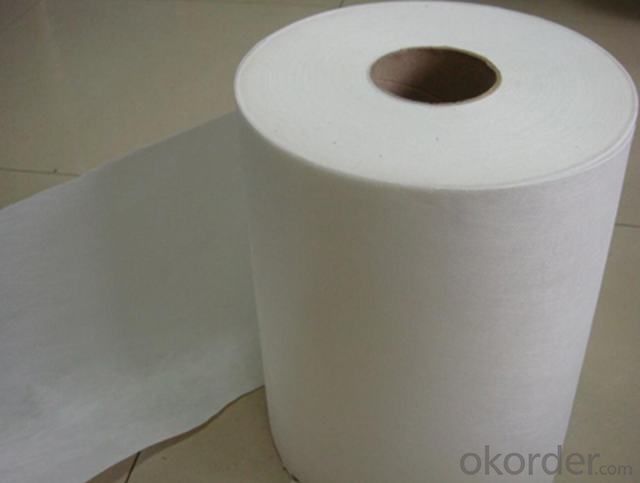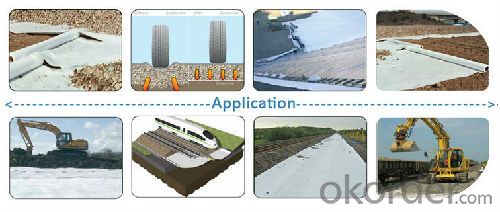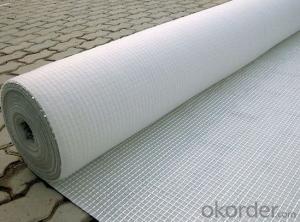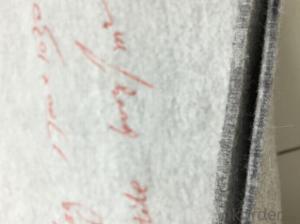Geotextile Mulch Pet Filament Spunbond Needle Punched
- Loading Port:
- Qingdao
- Payment Terms:
- TT or L/C
- Min Order Qty:
- 10000 m²
- Supply Capability:
- 10000 m²/month
OKorder Service Pledge
OKorder Financial Service
You Might Also Like
(1) Product introduction
Short fiber knitting geotextile takes the polypropylene fiber or the polyester fiber short fiber as the primary material, after blooms the pine ,to comb, disorderly, craft productions so on shop net, acupuncture to become.
(2) Product features
1. Net holes are easy foe blockage, since net structure formed by indefinite fiber has variable and motility.
2. It has high permeation and can keep good permeation under the pressure of earthwork.
3. It has corrosion resistance, uses chemical fiber such as polypropylene or Dacron as raw material, has acid and alkali resistance, hasn’t corrosion or moth-eaten and has oxidation resistance.
4. It has convenient construction, small weight and convenient uses.
(3) Application range
1. It isolates building material with different physical features, makes two or multiple material with out erosion or mixing, keeps overall structure and functions of material and makes load bearing capacity of structure strength.
2. When water flows into coarse soil layer from fine soil layer, it uses good gas and water permeation of knitting geotechnical cloth, allows water flow to pass and effectively holds back soil particle, fine sand and small stone so as to keep stability of water conservation project.
3. Knitting geotechnical cloth is good water guide material, and can form drainage channel in soil body and remove excessive liquid and gas from soil structure.
4. It uses knitting geotechnical cloth to strengthen tension resistance strength and deformation capacity of soil body, to strengthen stability of structure and to improve soil body quality.
5.It effectively diffuses, transmits or decomposes central stress and prevents soil body damage caused by functioning of external force.
6. Knitting geotechnical cloth matches other material(mainly including asphalt or plastic or plastic film) and forms non-permeation isolation layer (mainly using for relaying and repair of highway).
7. Knitting geotechnical cloth can be widely used in various fields such as water conservation, hydropower, highway, railway, port, airport, sport field and gymnasium, tunnel, coastal beach land, reclaiming land and environmental protection and play the functions such as isolation, filter, drainage, reinforcement, protection and enclosure.



FAQ of our geotextile:
- Q: What can we do for the special customer?
A: Provide custom made service with customer's drawing; We make sure to provide you with the best solutions for your individual case. Whether standard items or non-standard items.
- Q: What can we supply?
A: We provide high levels of communication from start to finish.
- Q: What is our advantage?
A: Top Cemented Carbide has extensive business experience, Fast delivery and high quality.
- Q: What is the geotextile of polypropylene gb / t?
- GB / T-2017 Geosynthetics Static Crack Test (CBR Method) This standard specifies the method of measuring the breaking strength of geosynthetics by flat top pressing bar. This method is usually carried out on samples that specify the standard atmospheric humidity. This standard applies to all types of geosynthetics, but does not apply to materials with a pore size greater than 10mm.
- Q: What is the role of permeability in geotextiles?
- The role of permeability in geotextiles is to allow the passage of water or other fluids while restraining the movement of soil particles. It helps in drainage and filtration processes, preventing the buildup of excess moisture and maintaining the stability and integrity of the surrounding soil or substrate.
- Q: How do geotextiles help with reinforcement of embankments?
- Geotextiles help with the reinforcement of embankments by providing stabilization and strength to the soil, preventing erosion and promoting proper drainage. They act as a barrier by separating different layers of soil, preventing the intermixing of fine and coarse particles. This enhances the overall stability of the embankment and increases its load-bearing capacity. Additionally, geotextiles help to distribute the applied loads more evenly, reducing the potential for differential settlement and ensuring long-term stability of the embankment.
- Q: What are the main functions of geotextiles?
- The main functions of geotextiles include filtration, separation, reinforcement, and drainage in various civil engineering and construction applications.
- Q: What are the specifications for geotextiles in railway projects?
- The specifications for geotextiles in railway projects typically include factors such as material type, weight, strength, permeability, and durability. These geotextiles are required to have high tensile strength and puncture resistance to withstand the heavy loads and dynamic forces exerted by train traffic. They should also possess appropriate permeability to allow for effective drainage and prevent water accumulation. Additionally, geotextiles used in railway projects should be chemically stable, resistant to degradation from UV exposure, and capable of withstanding various environmental conditions.
- Q: Construction scheme of geotextile water filter
- Second, the design: program one: in strict accordance with the requirements of the national standard construction, 5-year warranty 1, in the smooth level of leveling the overall construction brushing JS waterproof latex or polyurethane waterproof coating, the thickness of the national standard 1 standard; Weak parts to do additional layer to strengthen; 2, do 20 ~ 30mm thick waterproof mortar protective layer, divided into two construction, layer waterproof layer of pulp interface; require nano-silicon waterproofing agent and expansion agent compound use. 3, backfill when asked not to smash the waterproof layer. 4, indoor ground practice ibid, the wall to do high 1m. Option 2: with reference to national standard requirements simple practice, the warranty period of 1 year 1, the overall construction of coated asbestos asphalt waterproof coating or waterproof cold primer, the thickness of the standard by the national standard 2; special weak parts to do additional layer to strengthen; Outside the protection, requiring the use of sticky or sticky sticky construction; 3, backfill when asked not to smash the waterproof layer. 4, indoor ground practice reference program one, the wall to do high 1m.
- Q: Can geotextiles be used for soil stabilization?
- Yes, geotextiles can be used for soil stabilization. They are commonly used in civil engineering projects to reinforce soils, prevent erosion, and improve the overall stability of the soil. Geotextiles can effectively distribute loads, control soil movement, and enhance the performance of the soil in various applications such as road construction, retaining walls, slopes, and landfills.
- Q: Composite geotextile plastic composite
- 1, plastic composite geotextile is woven with a woven fabric as the substrate, the extruded coated polyolefin resin film or polyolefin resin sandwich layer, the woven cloth and all kinds of Zhang made together. 2, the product made of bags with light weight, acid and alkali resistance, strength, moisture and other advantages. 3, widely used in chemical fertilizer, synthetic resin, coarse salt, ore and cement products such as packaging, is a good packaging of heavy packaging materials
- Q: What are the maintenance requirements for geotextile installations?
- The maintenance requirements for geotextile installations typically involve regular inspection to ensure the fabric is intact and functioning properly. Any signs of damage or deterioration should be repaired or replaced promptly. Additionally, geotextiles may require occasional cleaning to remove debris or sediment that can affect their performance. Overall, proper maintenance practices can help prolong the lifespan and effectiveness of geotextile installations.
- Q: How do geotextiles help with reinforcement of geosynthetic clay liner slopes?
- Geotextiles help with the reinforcement of geosynthetic clay liner slopes by providing additional strength, stability, and erosion control. They are placed between the clay liner and the slope, acting as a barrier to prevent soil movement and slippage. The geotextiles distribute the load more evenly, reducing the potential for slope failure and enhancing the overall performance and longevity of the liner system.
1. Manufacturer Overview
| Location | Taian City,Shandong Province,China |
| Year Established | 2008 |
| Annual Output Value | Above US$100 Million |
| Main Markets | Africa, Oceania, North America, Western Europe, Eastern Asia |
| Company Certifications | ISO9001;IS014001 Certificate |
2. Manufacturer Certificates
| a) Certification Name | |
| Range | |
| Reference | |
| Validity Period |
3. Manufacturer Capability
| a) Trade Capacity | |
| Nearest Port | Qingdao Port;Tianjing Port;Shanghai Port |
| Export Percentage | |
| No.of Employees in Trade Department | 21-30 People |
| Language Spoken: | English; Chinese; |
| b) Factory Information | |
| Factory Size: | 10,000-30,000 square meters |
| No. of Production Lines | Above 10 |
| Contract Manufacturing | Geotechnical Material (Geogrid,Fiberglass/Polyester Geogrid,Geocell,Geonet and Geomat,Plastic Safety Fence) |
| Product Price Range | Average |
Send your message to us
Geotextile Mulch Pet Filament Spunbond Needle Punched
- Loading Port:
- Qingdao
- Payment Terms:
- TT or L/C
- Min Order Qty:
- 10000 m²
- Supply Capability:
- 10000 m²/month
OKorder Service Pledge
OKorder Financial Service
Similar products
Hot products
Hot Searches
Related keywords

































